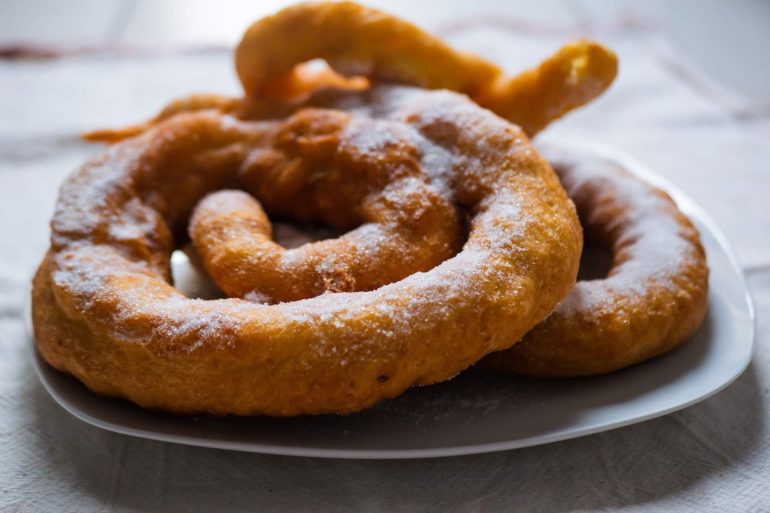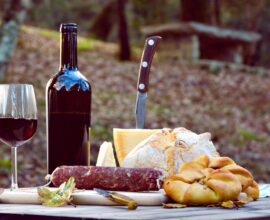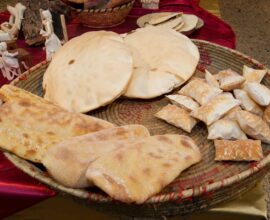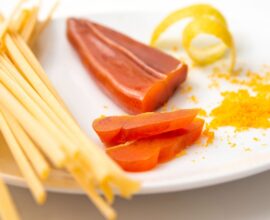Carnival at the table: the iconic sweets of Sardinian tradition
A journey discovering the delicacy of Sardinian Carnival sweets
Zippulas, gatzas, parafrittus, orillettas and uvusones: delicious and irresistible Carnival sweets characterizing the essence of Sardinian food tradition, clearly evident in the choice of typical local ingredients, that are”poor”, in a way, but no less rich of taste, among which the semolina flour, honey and citrus peel stand out.
Wherever you go, whatever Carnival sweet you find, the whole territory of Sardinia boasts a very rich culinary tradition, which includes plenty of different tastes, typical preparations and ingredients even just by moving from one village to another within the same province.
It is therefore difficult to give a complete overview of the endless variety of the iconic sweets related to the celebrations of Carnival in Sardinia (or Carrasegare) which officially begin on the night of January 17th with the so called fire rituals of Sant’Antonio Abate.
Anyway, it’s key to identify some recurring ingredients which, combined or processed in many different ways from town to town, originate a wide range of local traditional recipes which have been handed down from generation to generation for centuries. Some of the most important are the delicious Sardinian honey, sugar, the zest of fresh citrus fruits like lemons and oranges, saffron (a “precious” abundant spice that on the island), and the so-called pasta violada, a leavened preparation based on semolina flour and lard, an ingredient which is often used for frying these desserts as an alternative fat to oil.
As a matter of fact, these are mostly simple preparations that are strictly intertwined with the local culture bonded with a rural lifestyle, based on agriculture and pastoralism. Hence, this rustic and “poor” food tradition, but also very rich in all its flavors, goes beyond the simple “mixing of a few ingredients”; it becomes a real opportunity to gather together with family and friends and have a great time. After all, conviviality it’s exactly the cornerstone around which all the Sardinian Carnival celebrations has always revolved!
Zippulas, parafrittus, uvusones e orillettas: the most loved Carnival sweets in Sardinia
Fried (very fried!), very soft, very caloric, simply “rich” in their simplicity: the iconic traditional sweets of the Sardinian Carnival have all that it takes to enjoy company, cheer up body and soul and give that pure and irresistible joy that is the ultimate purpose of Carnival parades and meals.
After all, during the most colorful celebration of the year everything is allowed, even some changes to your diet! Feel free to choose whether to fill your stomach with frati fritti, zippulas, culurgiones, acciuleddi, gatzas or uvusones, or maybe all of them!
Zippulas (or zeppole) e frisjioles (or long fritters)
At the table of the Sardinian Carnival zippulas cannot be missing: soft pancakes made with a leavened dough based on semolina flour, milk and eggs (some recipes also include potatoes or ricotta, ingredients which make them even softer and more delicious), flavored with orange peel, aniseed liqueur and (sometimes) saffron pistils, then fried in oil or lard and, finally, sprinkled onto a lot of icing sugar or honey.
The shape of zeppole varies depending on the area, according to local traditions: in the South, the dough is generally shaped into small donuts, while in the Centre and North they’re shaped as long golden snakes (the so-called long fritters or Sardinian frisjioles, also known as frisciolas in Oristano, bryniols in Alghero, and frisgiori in Sassari and Gallura), which are made simply by pouring the dough directly into boiling oil through a funnel.
Parafrittus (or frati fritti)
Similar to zippulas and widespread over the island, with small local variations in terms of specific aromas used (especially orange and lemon peel, grappa and aniseed liqueur) than the final result, there are also the so called parafrittus, also known as “fried friars”.
They are very soft friend donuts covered in sugar, to taste while they’re still warm to better appreciate their extreme goodness. Although the basic recipe and the preparation methods are very similar, to recognize the difference between an authentic parafrittus and a zeppola is very simple.
The former are donuts-shaped, usually brown-colored and have a lighter line on the surface which forms as it rises to the surface after being fried in boiling oil and which, with a little imagination, just resembles a friar’s robe (hence the name “fried friars“).
On the other hand, zeppole are golden, softer and have an irregular shape. At any rate, these are real “clouds” of pure pleasure that you shouldn’t miss when you visit Sardinia at Carnival (some restaurants and pastry shops usually prepare them even throughout the year).
Uvusones
Fried and enriched with a warm and captivating filling made by the combination of acacia honey and filu ‘e ferru (a Sardinian brandy with a very strong flavor), uvusones are small soft balls with a very delicate flavor made with a cream puffs-like dough, also known as choux pastry. It’s definitely one of the most delicious and irresistible Carnival desserts of the Sardinian tradition: after all, it’s true that “one uvusones leads to another“!
Orillettas (or Sardinian “lies”)
The orillettas, also known as lorighittas or montogadas by moving from town to town, are nothing other than the “Sardinian” reinterpretation of the lies (or chiacchiere), a widespread Carnival sweet, typical of Nuoro and Gallura, with some small variations in terms of shape and ingredients.
In this case, the dough made from eggs, sugar, butter or lard, and flour is firstly rolled out into long thin strips, then rolled up in the shape of an “accordion”, and finally fried in boiling oil. It was once much more common to use lard or s’ozu casu (the fat obtained from the preparation of cheese) and, finally, covered with a pouring of hot honey and citrus peels.
Gatzas (or gathas)
Perhaps less known, but no less delicious, here are the gatzas (also known as gathas or cattas), that are pancakes made with a leavened dough based on semolina flour, water, lard and sourdough (or brewer’s yeast), very similar to that commonly used for the preparation of bread and sometimes enriched with potatoes to make them softer.
Considering the absence of eggs, sugar or other sweeteners, this particular dough matches very well with both sweet and savory ingredients, such as sugar in the first case and cold cuts, cheeses or typical cured meats for the salty version.
Acciuleddi, culurgiones e arrubiolus
This roundup of typical sweet delicacies of the Sardinian Carnival concludes with three more traditional preparations: acciuleddi, a specialty from the Gallura made with pasta violada (that is a dough made from semolina and water, enriched with lard or butter), shaped as small braids and dipped in honey; culurgiones de mendula (made with almond), that are fried sweet ravioli filled with almond paste and sprinkled of icing sugar; and the arrubiolus, the Sardinian version of castagnole, a kind of fried sweet balls made with ricotta, whose name seems to come from arrubiu (which means red in Sardinian), probably a reference to their reddish color given by the addition of egg yolks and saffron to the dough.
The taste of Sardinian tradition as a strength of the innovative ForteVillage’s gastronomy
A stay at ForteVillage, a luxury resort overlooking the crystal clear waters of Santa Margherita di Pula, is much more than a holiday to an exclusive location in South Sardinia.
It is a way of taking care of your physical, mental and spiritual well-being, thanks to the exclusive beauty treatments of the Acquaforte Thalasso and Spa, the possibility of accessing excellent sports facilities and drool after the richest and most varied gastronomy in the region, with 21 starred restaurants where to enjoy the authentic and taste of Sardinia’s cuisine, including the delicious sweets of the Sardinian Carnival, usually reinvented in a different and modern way according to the latest trends in the world of catering.
Of course, all with great respect and particular attention to the origin of the raw materials, specifically local and zero food miles, as many of which are picked directly from the ForteVillage Resort’s fruit and vegetables garden.
Do you want to savor the tasty authenticity of Sardinian cuisine and experience a fairytale holiday in an authentic paradise? Discover ForteVillage Resort in Sardinia






